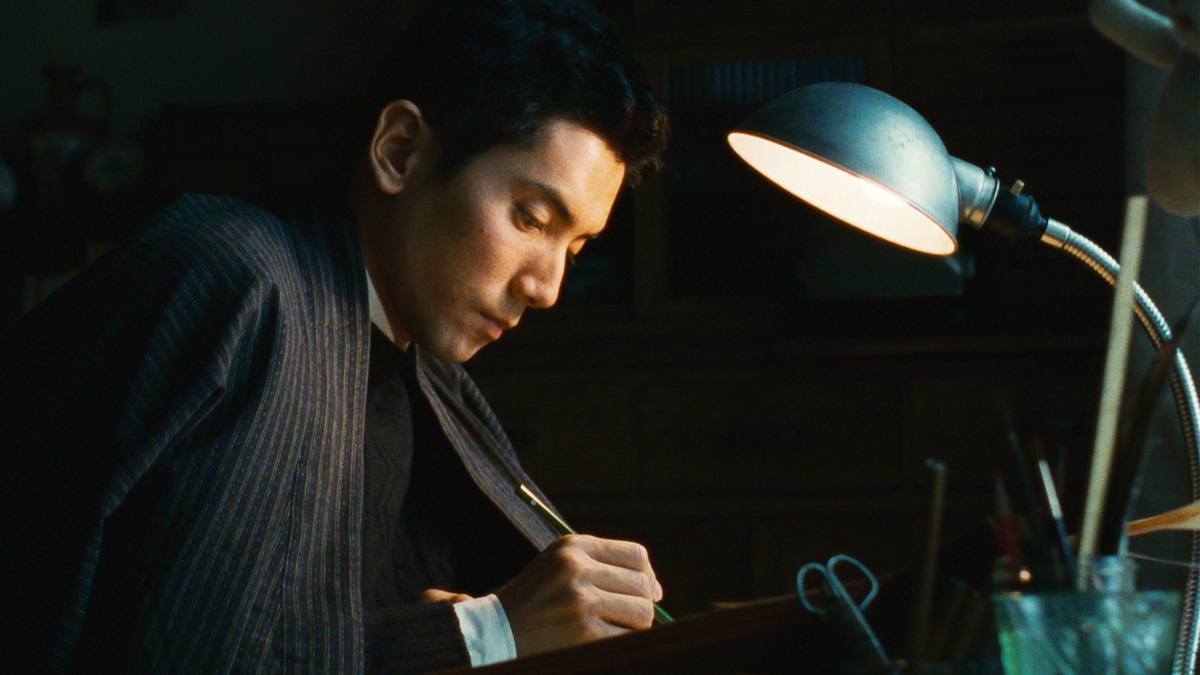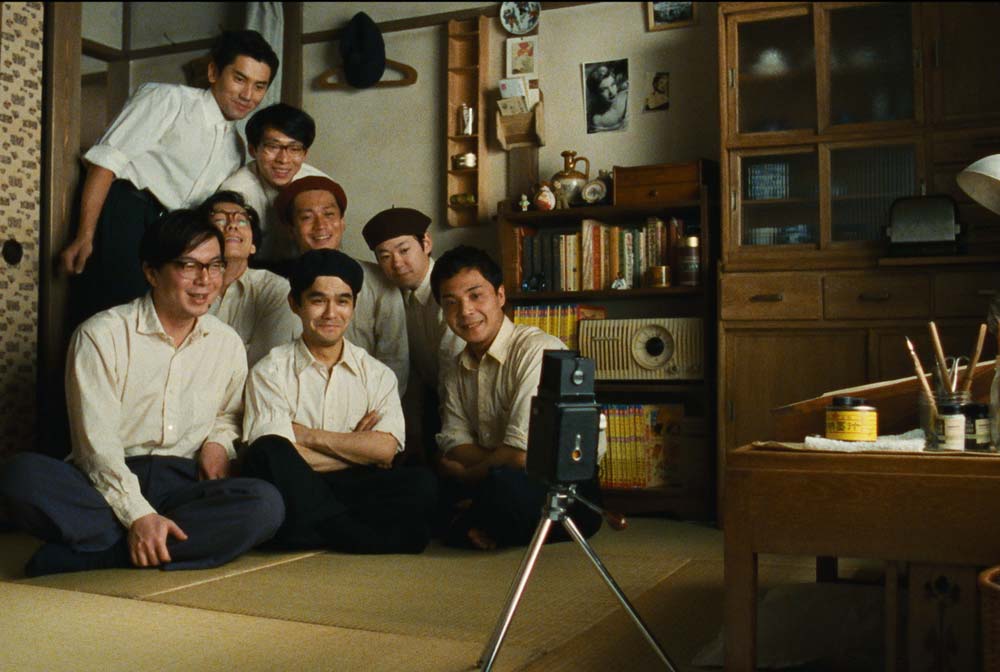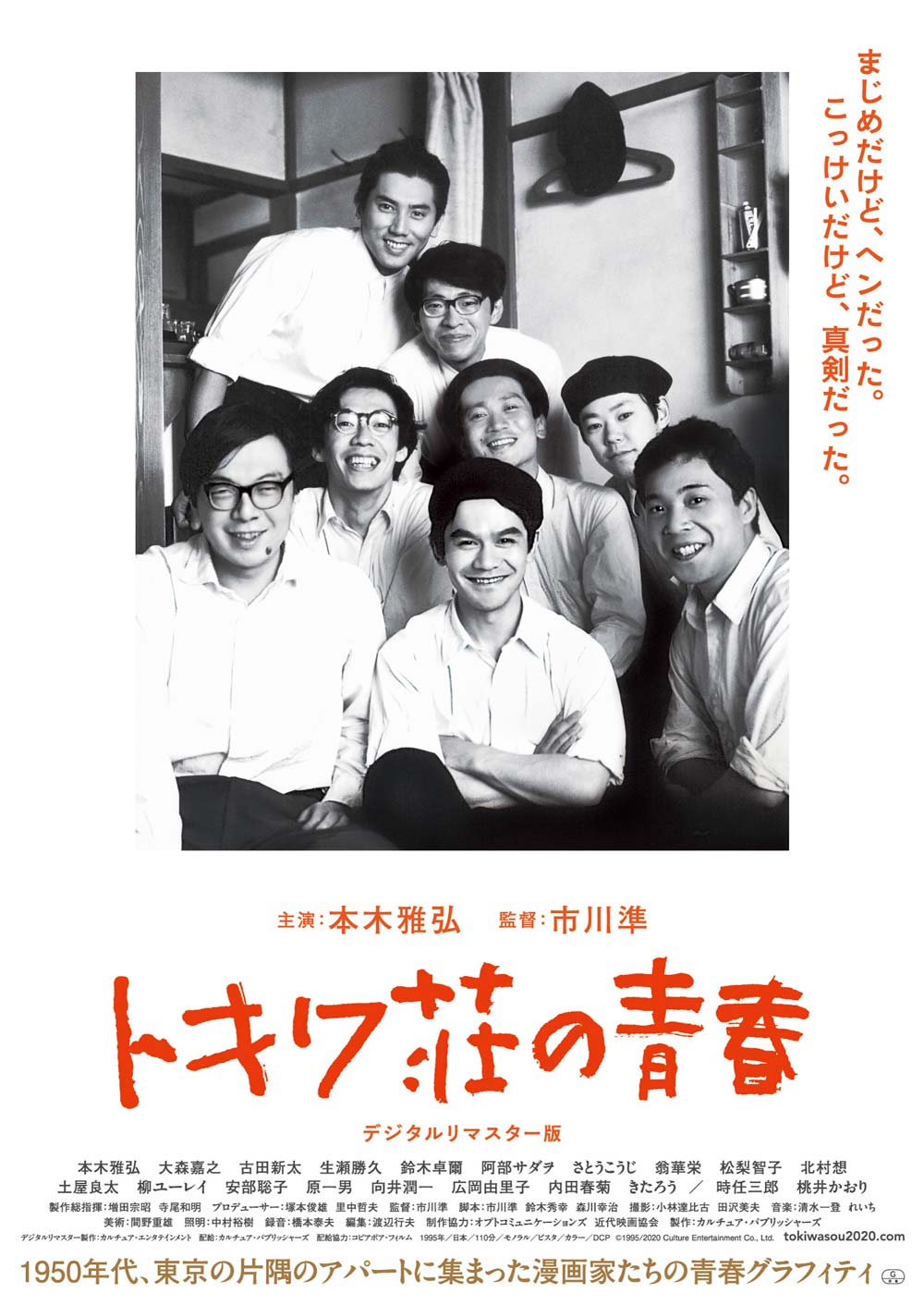
©1995/2020 Culture Entertainment Co., Ltd
"Tokiwa-so's Youth" The light and shadow of young manga artists drawn in the legendary apartment (Part 2/Photography part)
2021.02.13
Wonderful casting that combines Masahiro Motoki with a small theater actor
When real-life manga artists appear under their real names, an excuse is necessary. At the beginning of the work, there is a disclaimer that it is "a work of fiction based on historical fact."
But that doesn't mean it's okay to go crazy with creativity as long as this is released. For those who know the facts, excessive changes will be a turn-off. As many of the people involved are still alive, there is a possibility that they will complain. In fact, when the animation We Are Manga Artists: The Story of Tokiwa-so (1981) was made, Ishinomori Shotaro was involved as character designer and Suzuki Shinichi as director, which created an atmosphere of openness among the Tokiwa-so community, leading to confusion. According to Fujiko A,
"When it comes to the first draft of the script, everyone is whining and saying things like, 'I never said that.' It's a lot of work, because there are so many real-life models. And when it comes to the character charts drawn by Ishimori, there are constant requests like, 'Oh! Draw my face, even though it's so weird,' or, 'My legs are too short.' I'm worried that this is where it'll stop." (Tokiwa-so Youth Diary )
There was a big fuss about this. Fortunately, the people involved in "Tokiwa-so's Youth" were understanding, which allowed Ichikawa to be free to write the story. Even in an interview before writing the script, Akatsuka Fujio encouraged Ichikawa, saying, "It's fine to write fiction." That said, there are few episodes that deviate significantly from the historical facts, so even fans of Tokiwa-so can enjoy the story.
In terms of casting, the unexpected casting of the lead role of Hiroo Terada became a hot topic. In the drama " Manga Michi Seishun Hen ," the role was played by Eigo Kawashima (played by Kanji Watanabe in the previous series), and was well-received for being exactly as expected, but in "Tokiwa-so's Youth," the role was played by Masahiro Motoki.
At the time of the release, there was an opinion that Terada and Motoki were too different images. It is not surprising that they felt a sense of incongruity, as their appearances and auras are completely different. In "Tokiwa-so Seishun Nikki," which was republished to coincide with the release, Fujiko A. wrote, "Motoki's Tera-san shows a deep shadow of youth that he never showed us during his time at Tokiwa-so," in a roundabout way that made us feel a sense of incongruity.

“Tokiwa-so's Youth” ©1995/2020 Culture Entertainment Co., Ltd
The casting of Motoki was a request from the producers. Since the story was rather plain, it was decided that the lead role should be played by a flamboyant actor, but Ichikawa Jun also had the idea that if he let the lead role go as the producers wanted, he would be free to cast the rest of the cast. This may make it seem as though Ichikawa was unwilling to cast Motoki, but two years prior to this film, Ichikawa had shot a short film called "Lucky" for NHK-BS starring Motoki. This was the first time they had worked together, as Ichikawa had directed it at Motoki's request.
While Motoki was constantly starring in prime-time drama series during this time, his films, such as "Last Song" (1994), "RAMPO" (1994) and " GONIN " (1995), left a strong impression of being flashy and intense. Filming for "Tokiwa-so's Youth" overlapped with "GONIN" in parts, so Motoki ended up playing two roles with very different personalities, but Ichikawa noticed Motoki's sober side and restrained acting, and commented, "He would say, 'Don't overdo it,' but watching from behind the camera, he would give a pretty good performance with a deep inner voice. His reading comprehension was remarkable" (Cine Front, March 1996 issue).
Filming for this film began on June 8, 1995, on the interior set of Tokiwa-so, which was built on Stage 11 of the Nikkatsu Studios. The first scene to be shot was the opening scene of the film, in which Terada wakes up in a dim, cold room, gets ready, and starts drawing manga. Motoki later recalled this scene as follows:
"We shot the film during the hottest part of the summer, but I was surprised at how the images conveyed a cool seasonal feeling." (Kinema Junpo, late April 1996 issue)
When asked why he was able to easily immerse himself in the world of the film, he said, "There was a perfect set that allowed me to capture that atmosphere."
Last year, NHK's " Professional: Work Style by Masahiro Motoki " was a hot topic, and in addition to the unreleased special, there was even a rebroadcast with Motoki's voice added. At first glance, he was blessed with talent, but he always doubted his own abilities, and his earnestness in working hard despite being plagued by anxiety was just like Hiroo Terada in later years. Ichikawa must have found something in common with Terada in Motoki, who looks nothing like him.
In Fujiko A's book " 78 Years Old, Still Struggling to Go Manga... " (Chuokoron-Shinsha), published in 2012, he talks about "Tokiwa-so's Youth" from his present-day perspective. His true feelings are hard to discern from the publicity comments released around the time of the film's release, but here we can get his honest thoughts. Regarding Motoki's character, Terada, he reveals that his impression of him has changed, saying, "When I first saw it, I thought Motoki Masahiro was a little different from Terada, but after watching it many times, I realized that although he's different from the real Terada, he has a certain kind of solitary nature about him that comes across really well, and I've gradually come to like him better."
This statement is credible because in the book Fujiko A. says, "Even now, I watch "Tokiwa-so's Youth" over and over again on video." In particular, he says he watches the end credits after the last cut almost every day. There, " Chest Pendulum " plays, and the daily life of Tokiwa-so, filmed on black and white 8mm film, is shown. Apparently, they arranged for a day to gather around a hotpot in Terada's room during a break in filming, and perhaps this was filmed at one of these times, making you feel as if you are watching the real film from that time.
At the end, there is a shot where everyone gathers together for a commemorative photo, which is recreated in the same composition as the photo Fujiko A. actually took at the time. That is why Fujiko A. rewinds and watches the end credits over and over again, and when "Pendulum of the Heart" starts, he says, "I just can't help but cry," and is overcome with emotion. At this point, Osamu Tezuka, Hiroo Terada, Fujiko F. Fujio, Shotaro Ishinomori, and Fujio Akatsuka are no longer with us.

“Tokiwa-so's Youth” ©1995/2020 Culture Entertainment Co., Ltd
By the way, the casting of this film is very elaborate, as if Ichikawa's tastes were bursting at the seams. As expected from someone who often goes to small theaters, one highlight is the casting of actors who are already well-known in the world of theater but have not yet had much experience in film. The names of the theater companies they belonged to at the time of filming are listed below: Abe Sadao (Otona Keikaku), appearing in his second film, as Fujiko F. Fujio; Kitamura So (Project Navi) as Tezuka Osamu; Furuta Arata (Gekidan Shinkansen), also appearing in his second film, as Moriyasu Naoya; Namase Katsuhisa (Gekidan Sotoba Komachi) as Suzuki Shinichi; and Abe Satoko (Seinendan) as Ishinomori Shotaro's sister. Other veteran stage actors such as Sato Koji as Ishinomori and Okina Kae as Tsunoda Jiro are also in the cast, which is truly luxurious.
The film's creators also appear in the film. The editor-in-chief of Gakkosha's Manga Shonen magazine is played by Hara Kazuo, director of Yukiyukite Shingun (1987) and Reiwa Ikki (2019).
At first glance, Ichikawa and Hara seem to have no common ground, but Hara was the B-group cinematographer for Ichikawa's "No Life King" (1989). Hara, who had also worked as a cinematographer on " Proof of the Man " (1977) and " Vengeance is Mine " (1979), was asked to assist with the filming of "The Gods Go By." However, it seems that Ichikawa and Hara had no chance to talk at the time, and since Ichikawa and Hara were both exhibiting " Tokyo Brothers " and " The Whole Body Novelist " (1994) at the Berlin Film Festival in February 1995, they ended up spending the night together at a hotel bar and hitting it off. At that meeting, Hara apparently directly asked Ichikawa if he wanted to appear in a film. On the return flight, Ichikawa was absorbed in reading the production notes for "The Gods Go By" that Hara had given him, and he came up with the idea for "Tokiwa-so's Youth so." It seems that this encounter led to Hara's performance, which was full of humanity, even though it was only a short scene. The scene that was shot was apparently longer, but was cut due to running time restrictions. The original edit of the film was nearly four hours long, and the episodes were trimmed down to arrive at the current version.
Takuji Suzuki, who played Fujiko Fujio A, was a known figure only to a few at the time, having worked as an independent filmmaker at the time, and having also contributed to the screenplay for director Yaguchi Shinobu's " Barefoot Picnic " (1993), and starred in "Summer Memories: The Extraordinary, the Pleasure, the Pleasure, the Murder" (1995). However, he is now an actor who has appeared in many popular works, and as a film director, he has received high praise for his work on such films as " GeGeGe no Nyobo " (2010) and " Randen " (2019).
Matsunashi Tomoko, who plays Mizuno Eiko, was cast in the film due to her involvement in a film that Ichikawa had entered at the PFF (Pia Film Festival), where she served as a judge. Although she was unknown at this stage, she went on to appear in Hirano Katsuyuki's "Nagaremono Zukan" (1998) after this, and went on to star in " Dokufu Matilda " (1998), which she directed and starred in, becoming a prominent presence in independent films of the time.
At the time of the film's release, the cast was criticized as being too hobby-like, but Ichikawa himself said, "I get along better with these kinds of people" (Tokyojin, April 1996 issue), and he made good use of each individual's individuality, and even the actors with little film experience made their presence felt with ease and in their own style. Ichikawa's foresight in pairing these two actors from the worlds of theater and film, Abe Sadao and Suzuki Takuji, who played the two Fujiko Fujio characters like living replicas, is no less impressive than that of Terada Hiroo.
Motoki felt at a disadvantage facing such a cast. In particular, certain types of star quality can stand out in a negative way in a film like this. He expressed his anxiety as follows:
"When I'm creating a play, I rely on the director's instructions and the script, hoping to come up with something of my own within that. But the people at the small theater seem to mix their everyday lives with their play-making..." (Kinema Junpo, late April 1996 issue)
The earnestness with which he worries like this makes him the perfect fit for the role of Hiroo Terada. Motoki's naive performance, intimidated by the talented young actors who come from different backgrounds than himself, overlaps with Terada's, even though there is a difference between the play and the manga.
"Tokiwa-so's Youth Earthquake, followed by the Tokyo subway sarin gas attack in March, and society was shrouded in a dark mist. May 16th, when the scene of Terada and Tanashita Teruo meeting in Ginza was shot, was the day Asahara Shoko was arrested, and the city was on high alert. This film was shot in Tokyo, where the aftershocks of the Aum Shinrikyo incident were still continuing.
In an interview for the making-of "Movie Diary," Ichikawa Jun explained his reason for looking back to the past, saying, "It was a time when there were so many horrible disasters and incidents, that I no longer had any love for people. Even when I stand on a street corner and look at people, I can't really feel any love for them. But maybe it wasn't like that in the past." He then added with a sense of relief, "At a time like that, I was able to make a film that is full of the joy of seeing people."
“Tokiwa-so's Youth” preview
It's been 25 years since its release in March 1996. In an era that is as dark as it was back then, "Tokiwa-so's Youth" will return to the big screen once again. It will surely bring hope and joy to the viewers.
Click here for the first part and planning part
[Main References]
"Estria Quarterly No. 2" (Estria Doujin), " The Era of Tokiwa-so " (by Kajii Jun, Chikuma Shobo, Chikuma Bunko), " Tokiwa-so Youth Diary " (by Fujiko Fujio, Kobunsha/Fukkan.com), " Tokiwa-so Youth Story " (by Tezuka Osamu and 13 others, Kagyusha), " The Two of Us Just Drew Manga: A Personal History of Postwar Children's Manga " (by Fujiko Fujio, Mainichi Shimbun), " I'm a Manga Artist: Tezuka Osamu's Autobiography 1 " (by Tezuka Osamu, Yamato Shobo), " Chapter 1: Tokiwa-so: Spring " (by Ishinomori Shotaro, Kodansha), " Records of the Last Resident of Tokiwa-so " (by Yamauchi George, Tokyo Shoseki), " The True Story of Tokiwa-so: Tezuka Osamu and the Youth of Manga Artists " (by Maruyama Akira, Shogakukan Bunko), " The "Tokiwa-so" Outlaw School "The Biography of Manga Artist Moriyasu Naoya " (by Ibuki Hayato, published by Shakai Hyoronsha), "The History of Manga Boys" (edited by Terada Hiroo, published by Shonan Publishing),
"Reprint Edition Manga Shonen" (Kokusho Kankokai), " The Story of Manga Shonen: A Biography of Editor Kato Kenichi" (Kodansha), "Excerpts from the Kato Kenichi Diary" (Private Edition), " Collection of Tezuka Osamu Essays: A Record of My Memories " (by Tezuka Osamu, Ritsutosha), "Manga Classroom" (by Tezuka Osamu, Shogakukan), " A Dissection of the Way of Manga " (Sanei Shobo), " Love...At the Beginning of Its Beginnings...Mitsuka Michio's Youth " (by Fujiko Fujio A, Shogakukan), " 78 Years Old, Still on the Way of Manga..." (Fujiko Fujio A, Chuokoron-Shinsha), The Apartment as a Story (Kondo Tasuku, Sairyusha), A Study of "Ichikawa Jun" (Ichikawa Jun Research Group), Kinema Junpo, Monthly Scenario, Cine Front, Tokyojin, Bungeishunju, Sunday Mainichi, Weekly Gendai, Advertising Criticism, Yomiuri Shimbun, Asahi Shimbun, Mainichi Shimbun, theater pamphlets
Text: Guinea Pig Yoshida
Born in 1978. Movie critic. Another name is Ichiro Yoshida. He has written for ``Eiga Hiho'', ``Kinema Junpo'', ``Eiga Geijutsu'', ``Scenario'', etc. His books include ``Introduction to film criticism! ” (Yosensha), co-authored with “Film director Takeshi Kitano. ” (Film Art Company) and others

“Tokiwa-so's Youth Digital Remastered Version”
Released nationwide from Friday, February 12, 2021 at Theater Shinjuku, Cinelibre Ikebukuro, and others
©1995/2020 Culture Entertainment Co., Ltd

